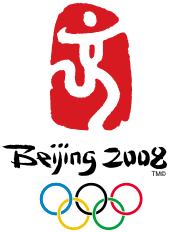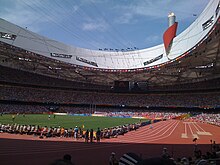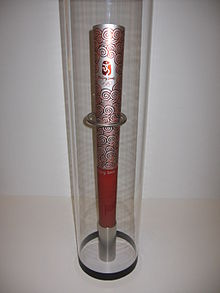2008 Summer Olympics
 The "Dancing Beijing" emblem, depicting aChinese seal inscribed with the character "Jīng" (京), from the name of the host city, in the form of a dancing figure. | |
| Host city | Beijing, China |
|---|---|
| Motto | One World, One Dream (同一个世界 同一个梦想) |
| Nations participating | 204 NOCs |
| Athletes participating | 10,942 (4,637 women, 6,305 men)[1] |
| Events | 302 in 28 sports |
| Opening ceremony | August 8 |
| Closing ceremony | August 24 |
| Officially opened by | President Hu Jintao |
| Athlete's Oath | Zhang Yining |
| Judge's Oath | Huang Liping |
| Olympic Torch | Li Ning |
| Stadium | Beijing National Stadium |
| Part of a series on |
The 2008 Summer Olympic Games, officially known as the Games of the XXIX Olympiad (Chinese: 第二十九届夏季奥林匹克运动会), was a major international multi-sport event that took place in Beijing, China, from August 8 to 24, 2008.[a] A total of 10,942 athletes from 204 National Olympic Committees (NOCs) competed in 28 sports and 302 events (a total of one event more than the schedule of the 2004 Games). China became the 22nd nation to host the Olympic Games and the 18th to hold a Summer Olympic Games. It was the third time that the Summer Olympic Games were held in Asia, after Tokyo, Japan, in 1964 and Seoul, South Korea, in 1988. The equestrian events were held in Hong Kong, making it the third time the events of the same Olympics were held under the jurisdiction of two different NOCs[b], while sailing was contested inQingdao, and football events took place in several different cities.
Beijing was awarded the Games over four competitors on July 13, 2001, having won an absolute majority of votes from members of theInternational Olympic Committee (IOC) after two rounds of voting.[2] The Government of the People's Republic of China promoted the Games and invested heavily in new facilities and transportation systems. A total of 37 venues were used to host the events, including 12 constructed specifically for use at the Games. The official logo of these Olympic Games, titled "Dancing Beijing", refers to the host city by featuring a stylised calligraphic character jīng (京, meaning capital). The Games were the most watched Olympics in history, attracting 4.7 billion viewers worldwide.[3][4] Some politicians and non-governmental organizations criticized the choice of China as Olympic host because of the country'shuman rights record,[5][6] and protests by pro-Tibetan independence activists and critics of China's human rights record marred the international portion of the Olympic torch relay.
There were 43 world records and 132 Olympic records set at the 2008 Summer Olympics. An unprecedented 86 countries won at least one medal during the Games. Chinese athletes won the most gold medals, with 51, and 100 medals altogether, while the United States had the most total medals with 110. The 2008 Summer Olympics is the most watched event in human history, having been watched by 5 billion people, more than 70% of the human population.
Contents
[hide]Organization[edit]
Bid[edit]
Beijing was elected as the host city for the 2008 Summer Olympics on July 13, 2001, during the 112th IOC Session in Moscow, defeating bids from Toronto, Paris, Istanbul, and Osaka. Prior to the session, five other cities (Bangkok, Cairo, Havana, Kuala Lumpur, and Seville) had submitted bids to the IOC but failed to make the short list chosen by the IOC Executive Committee in 2000. After the first round of voting, Beijing held a significant lead over the other four candidates. Osaka received only six votes and was eliminated. In the second round, Beijing was supported by an absolute majority of voters, eliminating the need for subsequent rounds.[7]
Members of the IOC did not disclose their votes, but news reports speculated that broad international support led to China's selection, especially from developing nations who had received assistance from China in the construction of stadiums. The size of China, its increased enforcement of doping controls, and sympathy concerning its loss of the 2000 Summer Olympics to Sydney were all factors in the decision.[8] Eight years earlier, Beijing had led every round of voting for the 2000 Summer Olympics before losing to Sydney by two votes in the final round.[9]
Human rights concerns expressed by Amnesty International and politicians in both Europe and the United States were considered by the delegates, according to IOC Executive Director François Carrard. Carrard and others suggested that the selection might lead to improvements in human rights in China. In addition, a number of IOC delegates who had formerly been athletes expressed concern about heat and air quality during the Games. China outlined plans to address these environmental concerns in its bid application.[8]
| 2008 Summer Olympics bidding results | |||
|---|---|---|---|
| City | NOC | Round 1 | Round 2 |
| Beijing | 44 | 56 | |
| Toronto | 20 | 22 | |
| Paris | 15 | 18 | |
| Istanbul | 17 | 9 | |
| Osaka | 6 | — | |
Costs[edit]
On March 6, 2009, the Beijing Organizing Committee for the Olympic Games reported that total spending on the games was "generally as much as that of the Athens 2004 Olympic Games", which was equivalent to about US$15 billion. They went on to claim that surplus revenues from the Games would exceed the original target of $16 million.[10] Other reports, however, estimated the total costs from $40 billion to $44 billion, which would make the Games "far and away the most expensive ever".[11][12][13]
Its budget has since been exceeded by the 2014 Winter Olympics in Sochi, which suffered from major cost overruns, causing the budget to exceed US$51 billion.[14][15]
Venues[edit]
By May 2007 the construction of all 31 Beijing-based Olympic Games venues had begun.[16] The Chinese government renovated and constructed six venues outside Beijing as well as 59 training centres. The largest structures built were the Beijing National Stadium, Beijing National Indoor Stadium, Beijing National Aquatics Center, Olympic Green Convention Center, Olympic Green, and Beijing Wukesong Culture & Sports Center. Almost 85% of the construction budget for the six main venues was funded by $2.1 billion (RMB¥17.4 billion) in corporate bids and tenders. Investments were expected from corporations seeking ownership rights after the Olympics.[17] Some events were held outside Beijing, namely football in Qinhuangdao, Shanghai,Shenyang, and Tianjin; sailing in Qingdao; and, because of the "uncertainties of equine diseases and major difficulties in establishing a disease-free zone", the equestrian events were held in Hong Kong.[18]
The centrepiece of the 2008 Summer Olympics was the Beijing National Stadium, nicknamed "The Bird's Nest" because of its nest-like skeletal structure. The stadium hosted both the opening and closing ceremonies as well as the athletics competition.[19] Construction of the venue began on December 24, 2003. The Guangdong Olympic Stadium was originally planned, constructed, and completed in 2001 to help host the Games, but a decision was made to construct a new stadium in Beijing.[20] In 2001, the city held a bidding process to select the best arena design. Several criteria were required of each design, including flexibility for post-Olympics use, a retractable roof, and low maintenance costs.[21] The entry list was narrowed to thirteen final designs.[22] The bird's nest model submitted by architects Jacques Herzog and Pierre de Meuron in collaboration with Li Xinggang of China Architecture Design and Research Group (CADG) was selected as the top design by both a professional panel and by a broader audience during a public exhibition. The selection of the design became official in April 2003.[21] Construction of the stadium was a joint venture among the original designers, project architect Stefan Marbach, artist Ai Weiwei, and a group of CADG architects led by Li Xinggang. Its $423 million cost was funded by the state-owned corporate conglomerate CITIC and the Beijing State-Owned Assets Management Company.[21][23]
The 2008 Beijing Olympics caused traditional Hutong neighborhoods to be cleared for the construction of modern Olympic stadiums. In an effort to ensure success for the games, the government invested billions in building new infrastructure, although clearance to tiny, outdated neighborhoods in Beijing called hutongs resulted (Petrun). Jim Yardley, a New York Times reporter interviews Pan Jinyu, a 64-year-old local resident: “They [the government] don’t want foreigners to see this scarred old face”. Feng Shuqin and her husband, Zheng Zhanlin have lived in their house for 50 years and the family has owned the property before the Communists took control in 1949. The government, trying to clear the area, has offered them to move with a compensatory sum of $175,000 USD, but the family insists the land is worth $1.4 million USD (Yardley). Michael Meyer, an American who lives in the hutongs reported that a total of 500,000 residents were relocated from their homes before the Olympics began (Meyer).
Transport[edit]
To prepare for Olympic visitors, Beijing's transportation infrastructure was expanded. Beijing's airport underwent a major renovation with the addition of the new Terminal 3, designed by architect Norman Foster.[24] Within the city itself, Beijing's subway was doubled in capacity and length, with the addition of 7 lines and 80 stations to the previously existing 4 lines and 64 stations. Included in this expansion was a new link connecting to the city's airport. A fleet of thousands of buses, minibuses, and official cars transported spectators, athletes, and officials between venues.[25][26]
In an effort to improve air quality, the city placed restrictions on construction sites and gas stations, and limited the use of commercial and passenger vehicles in Beijing.[27] From June 20 through September 20, passenger vehicle restrictions were placed on alternate days depending on the terminal digit of the car's license plate. It was anticipated that this measure would take 45% of Beijing's 3.3 million cars off the streets. The boosted public transport network was expected to absorb the demand created by these restrictions and the influx of visitors, which was estimated at more than 4 million additional passengers per day.[28]
Marketing[edit]
The 2008 Summer Olympics emblem was known as Dancing Beijing. The emblem combined a traditional Chinese red seal and a representation of thecalligraphic character jīng (京, "national capital", also the second character of Beijing's Chinese name) with athletic features. The open arms of the calligraphic word symbolised the invitation from China to the world to share in its culture. IOC president Jacques Rogge was very happy with the emblem, saying, "Your new emblem immediately conveys the awesome beauty and power of China which are embodied in your heritage and your people."[29]
The official motto for the 2008 Olympics was "One World, One Dream" (同一个世界 同一个梦想).[30] It called upon the whole world to join in the Olympic spirit and build a better future for humanity, and was chosen from over 210,000 entries submitted from around the world.[31] Following the announcement of the motto, the phrase was used by international advocates of Tibetan secession. Banners reading "One World, One Dream, Free Tibet" were unfurled from various structures around the globe in the lead up to the Beijing Olympics, such as from the San Francisco Golden Gate Bridge and the Sydney Opera House in Australia.[32]
The mascots of Beijing 2008 were the five Fuwa, each representing both a colour of the Olympic rings and a symbol of Chinese culture. In 2006, theBeijing Organizing Committee released pictograms of 35 Olympic disciplines (for some multi-discipline sports, such as cycling, a single pictogram was released).[33][34] This set of sport icons was named the beauty of seal characters, because of each pictogram's likeness to Chinese seal script.[34]
Media coverage[edit]
The 2008 Games were the first to be produced and broadcast entirely in high definition by the host broadcaster.[35] In comparison, American broadcaster NBC broadcast only half of the 2006 Turin Winter Games in HD.[36][37] In their bid for the Olympic Games in 2001, Beijing stated to the Olympic Evaluation Commission that there would be, "[N]o restrictions on media reporting and movement of journalists up to and including the Olympic Games."[38] However, some media outlets claimed that organizers ultimately failed to live up to this commitment.[c]
According to Nielsen Media Research, 4.7 billion viewers worldwide tuned into some of the television coverage, one-fifth larger than the 3.9 billion who watched the 2004 Olympic Games in Athens. American broadcaster NBC produced only 2 hours of online streaming video for the 2006 Winter Games but produced approximately 2,200 hours of coverage for the 2008 Summer Games. CNN reported that, for the first time, "live online video rights in some markets for the Olympics have been separately negotiated, not part of the overall 'broadcast rights.'" The new media of the digital economy was said to be growing "nine times faster than the rest of the advertising market."[39]
The international European Broadcasting Union (EBU) provided live coverage and highlights of all arenas only for certain territories on their website, Eurovisionsports.tv.[40] Many national broadcasters likewise restricted the viewing of online events to their domestic audiences.[41] The General National Copyright Administration of China announced that "individual (sic) and websites will face fines as high as 100,000 yuan for uploading recordings of Olympic Games video to the internet",[42] part of an extensive campaign to protect the pertinent intellectual property rights.[43][44] The Olympic Committee also set up a separate YouTube channel at Beijing 2008
Torch relay[edit]
The design of the 2008 Olympic Torch was based on traditional scrolls and used a traditional Chinese design known as the "Propitious Clouds" (祥云). The torch was designed to remain lit in 65 km/h (40 mph) winds, and in rain of up to 50 mm (2 in) per hour.[45]
The relay, with the theme "Journey of Harmony", was met with protests and demonstrations by pro-Tibet supporters throughout its journey. It lasted 130 days and carried the torch 137,000 km (85,000 mi)—the longest distance of any Olympic torch relay since the tradition began at the 1936 Berlin Games.[46][47] The torch relay was described as a "public relations disaster" for China by USA Today,[48] with protests against China's human rights record, particularly focused on Tibet. The IOC subsequently barred future Olympics organizers from staging international torch relays.[49]
The relay began March 24, 2008, in Olympia, Greece. From there, it traveled across Greece to Panathinaiko Stadium in Athens, and then to Beijing, arriving on March 31. From Beijing, the torch followed a route passing through every continent except Antarctica. The torch visited cities on the Silk Road, symbolizing ancient links between China and the rest of the world. A total of 21,880 torchbearers were selected from around the world by various organizations and entities.[50]
The international portion of the relay was problematic. The month-long world tour encountered wide-scale protests. After trouble in London involving attempts by protestors to put out the flame, the torch was extinguished in Paris the following day.[51] The American leg in San Francisco on April 9 was altered without prior warning to avoid such disturbances, although there were still demonstrations along the original route.[52] The relay was further delayed and simplified after the 2008 Sichuan earthquake hit western China.[53]
The flame was carried to the top of Mount Everest[50] on a 108 km (67 mi) long "highway" scaling the Tibetan side of the mountain, built especially for the relay. The $19.7 million blacktop project spanned from Tingri County of Xigazê Prefecture to the Everest Base Camp.[54] In March 2008, China banned mountaineers from climbing its side of Mount Everest, and later persuaded the Nepalese government to close their side as well, officially citing environmental concerns.[55] It also reflected concerns by the Chinese government that Tibet activists may try to disrupt its plans to carry the Olympic torch up the world's tallest peak.[56]
The originally proposed route would have taken the torch through Taipei after leaving Vietnam and before heading for Hong Kong. However, the government of Taiwan (then led by the independence-leaning Democratic Progressive Party) objected to this proposal, claiming that this route would make the portion of the relay in Taiwan appear to be part of the torch's domestic journey through China, rather than a leg on the international route.[57]This dispute, as well as Chinese demands that the flag and the national anthem of the Republic of China be banned along the route led the government of Taiwan to reject the proposal that it be part of the relay route, and the two sides of the Taiwan Strait subsequently blamed each other for injecting politics into the event.[58]




